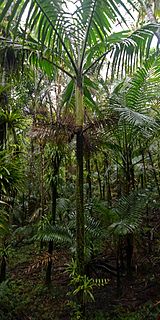
The pygmy killer whale is a poorly known and rarely seen oceanic dolphin. It derives its common name from sharing some physical characteristics with the killer whale. It is the smallest species that has "whale" in its common name. Although the species has been known to be extremely aggressive in captivity, this aggressive behavior has not been observed in the wild.

The pantropical spotted dolphin is a species of dolphin found in all the world's temperate and tropical oceans. The species was beginning to come under threat due to the killing of millions of individuals in tuna purse seines. In the 1980s, the rise of "dolphin-friendly" tuna capture methods saved millions of the species in the eastern Pacific Ocean and it is now one of the most abundant dolphin species in the world.

The knobcone pine, Pinus attenuata, is a tree that grows in mild climates on poor soils. It ranges from the mountains of southern Oregon to Baja California with the greatest concentration in northern California and the Oregon-California border.

Agave attenuata is a species of agave sometimes known as the "lion's tail," "swan's neck," or "foxtail" for its development of a curved inflorescence, unusual among agaves. Native to the plateau of the State of Jalisco in central Mexico, as one of the unarmed agaves, it is popular as an ornamental plant in gardens in many other places with subtropical and warm climates. It is reportedly naturalized in Libya.

Banksia attenuata, commonly known as the candlestick banksia, slender banksia or biara as known by the Noongar aboriginal people, is a species of plant in the family Proteaceae. Commonly a tree, it reaches 10 m (33 ft) high, but is often a shrub in drier areas 0.4 to 2 m high. It has long narrow serrated leaves and bright yellow inflorescences, or flower spikes, held above the foliage, which appear in spring and summer. The flower spikes age to grey and swell with the development of the woody follicles. It is found across much of the southwest of Western Australia, from north of Kalbarri National Park down to Cape Leeuwin and across to Fitzgerald River National Park.

The Asian gray shrew is a species of mammal in the family Soricidae. It is found in Bhutan, Cambodia, China, India, Laos, Malaysia, Myanmar, Nepal, Pakistan, the Philippines, Thailand, and Vietnam. It is one of the commonest species within its range and the International Union for Conservation of Nature has assessed its conservation status as being of "least concern".

Samoana attenuata is a species of air-breathing tropical land snail, a terrestrial pulmonate gastropod mollusk in the family Partulidae. This species is endemic to French Polynesia.

Gaussia attenuata is a palm which is native to the Dominican Republic and Puerto Rico. The species grows on steep-sided limestone hills in Puerto Rico.
Verticordia attenuata is a flowering plant in the myrtle family, Myrtaceae and is endemic to the south-west of Western Australia. It is a shrub with a single main stem, small leaves and pink to purple flowers which fade to white as they age. It usually grows in sand in areas that are wet in winter, often amongst grasses and is found in coastal areas near Bunbury.

Agave is a genus of monocots native to the hot and arid regions of Mexico and the Southwestern United States. Some Agave species are also native to tropical areas of South America. The genus Agave is primarily known for its succulent and xerophytic species that typically form large rosettes of strong, fleshy leaves. Plants in this genus may be considered perennial, because they require several to many years to mature and flower. However, most Agave species are more accurately described as monocarpic rosettes or multiannuals, since each individual rosette flowers only once and then dies ; a small number of Agave species are polycarpic.

Castilleja attenuata is a species of Indian paintbrush, known by the common names valley tassels and attenuate Indian paintbrush.

Nicotiana attenuata is a species of wild tobacco known by the common name coyote tobacco. It is native to western North America from British Columbia to Texas and northern Mexico, where it grows in many types of habitat. It is a glandular and sparsely hairy annual herb exceeding a meter in maximum height. The leaf blades may be 10 centimetres (4 in) long, the lower ones oval and the upper narrower in shape, and are borne on petioles. The inflorescence bears several flowers with pinkish or greenish white tubular throats 2 to 3 centimetres long, their bases enclosed in pointed sepals. The flower face has five mostly white lobes. The fruit is a capsule about 1 centimetre long.

Vinciguerria attenuata, commonly known as the slender lightfish, is a small species of ray-finned fish in the family Phosichthyidae, found in deep water in warmer parts of the Atlantic, the Indian and Pacific Oceans.
Attenuata is a genus of minute sea snails, marine gastropod mollusks or micromollusks in the family Lironobidae.

Haworthiopsis attenuata, formerly Haworthia attenuata, the zebra haworthia, is a small species of succulent plant from the Eastern Cape Province, South Africa. As an ornamental, it is one of the most commonly cultivated of the Haworthiopsis species.
Hoplorana is a genus of longhorn beetles of the subfamily Lamiinae, containing the following species:
Hoplorana parterufa is a species of beetle in the family Cerambycidae. It was described by Stephan von Breuning in 1980. It is known from Madagascar.
Hoplorana quadricristata is a species of beetle in the family Cerambycidae. It was described by Fairmaire in 1896. It is known from Madagascar.
Hoplorana vadoni is a species of beetle in the family Cerambycidae. It was described by Stephan von Breuning in 1957. It is known from Madagascar.
Hoplorana nigroscutata is a species of beetle in the family Cerambycidae. It was described by Fairmaire in 1905. It is known from Madagascar.














